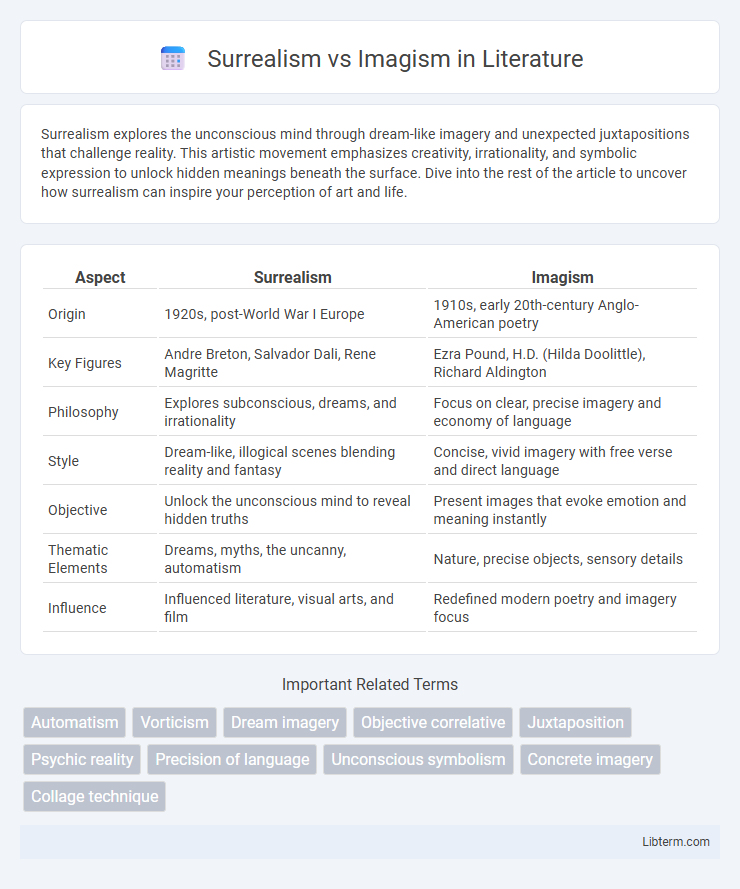Surrealism explores the unconscious mind through dream-like imagery and unexpected juxtapositions that challenge reality. This artistic movement emphasizes creativity, irrationality, and symbolic expression to unlock hidden meanings beneath the surface. Dive into the rest of the article to uncover how surrealism can inspire your perception of art and life.
Table of Comparison
| Aspect | Surrealism | Imagism |
|---|---|---|
| Origin | 1920s, post-World War I Europe | 1910s, early 20th-century Anglo-American poetry |
| Key Figures | Andre Breton, Salvador Dali, Rene Magritte | Ezra Pound, H.D. (Hilda Doolittle), Richard Aldington |
| Philosophy | Explores subconscious, dreams, and irrationality | Focus on clear, precise imagery and economy of language |
| Style | Dream-like, illogical scenes blending reality and fantasy | Concise, vivid imagery with free verse and direct language |
| Objective | Unlock the unconscious mind to reveal hidden truths | Present images that evoke emotion and meaning instantly |
| Thematic Elements | Dreams, myths, the uncanny, automatism | Nature, precise objects, sensory details |
| Influence | Influenced literature, visual arts, and film | Redefined modern poetry and imagery focus |
Understanding Surrealism: Origins and Principles
Surrealism originated in the early 1920s as an avant-garde movement founded by Andre Breton, emphasizing the liberation of the unconscious mind through dreamlike, irrational imagery and unexpected juxtapositions. Its principles revolve around automatic writing, free association, and exploring the subconscious to challenge rational thought and traditional artistic norms. Key figures such as Salvador Dali and Max Ernst exemplified surrealism's commitment to depicting surreal landscapes and bizarre motifs that transcend reality.
Imagism Explained: Key Concepts and Influences
Imagism, a literary movement emerging in the early 20th century, emphasizes clarity, precision, and economy of language, focusing on clear, sharp images to evoke emotions and ideas. Key concepts include the use of precise visual imagery, free verse, and the avoidance of unnecessary words, influenced heavily by Japanese haiku and classical Chinese poetry. Notable figures like Ezra Pound and H.D. (Hilda Doolittle) shaped Imagism's foundation, promoting a reaction against the abstractions of Romanticism and the verbosity of Victorian poetry.
Historical Context: Surrealism and Imagism Movements
Surrealism emerged in the early 1920s as a revolutionary artistic and literary movement rooted in the aftermath of World War I, drawing heavily on psychoanalytic theories by Freud to explore the unconscious mind through dream-like, illogical imagery. Imagism, which preceded Surrealism in the 1910s, originated as a modernist poetry movement in London and New York, emphasizing clarity, precision, and economy of language, reacting against the verbose Romantic and Victorian poetry of the 19th century. Both movements reflect early 20th-century cultural shifts but contrast in approach, with Imagism focusing on direct sensory experience and Surrealism on unlocking the subconscious and irrational.
Core Differences Between Surrealism and Imagism
Surrealism centers on exploring the unconscious mind through dreamlike, illogical, and fantastical imagery, emphasizing spontaneous creativity and blending reality with imagination. Imagism, by contrast, prioritizes clarity, precision, and economy of language, using vivid, concrete images to evoke sensory experiences with minimalistic expression. The core difference lies in Surrealism's focus on abstract, subconscious exploration versus Imagism's commitment to direct, sharp visual representation.
Notable Figures in Surrealism and Imagism
Surrealism features notable figures such as Andre Breton, Salvador Dali, and Rene Magritte, who explored the unconscious mind and dream imagery to challenge reality and traditional artistic forms. Imagism includes key poets like Ezra Pound, H.D. (Hilda Doolittle), and Richard Aldington, emphasizing clarity, precision, and vivid visual imagery in short free verse poems. Both movements revolutionized 20th-century art and literature by prioritizing innovative approaches to perception and expression.
Visual Imagery: Contrasts in Artistic Expression
Surrealism emphasizes dream-like, irrational visuals that challenge conventional perception through bizarre, fantastical imagery, while Imagism prioritizes clarity, precision, and concrete visual details to evoke vivid sensory experiences. Surrealist works often merge unexpected elements to create a subconscious narrative, contrasting with Imagist compositions that rely on succinct, sharply defined images grounded in reality. These differing approaches highlight surrealism's embrace of abstract imagination versus imagism's commitment to direct, clear visual representation.
Poetic Techniques in Surrealism vs Imagism
Surrealism employs dream-like imagery, free association, and automatic writing to unlock the unconscious mind, emphasizing irrational juxtapositions and symbolic metaphors. Imagism focuses on precise, clear images and concise language, using direct treatment of the subject and economy of words to evoke sensory experiences. While Surrealism embraces ambiguity and abstraction, Imagism prioritizes clarity, vividness, and spatial immediacy in poetic technique.
Impact on Modern Literature and Art
Surrealism revolutionized modern literature and art by emphasizing the unconscious mind, dream imagery, and irrational juxtapositions, profoundly influencing visual arts, poetry, and psychoanalytic approaches. Imagism, with its precise, clear, and concise language, reshaped modern poetry by focusing on sharp, direct images and economy of words, steering away from traditional poetic forms. Both movements challenged conventional aesthetics, with Surrealism fostering avant-garde experimentation and Imagism refining poetic clarity, leaving enduring legacies on contemporary creativity and artistic expression.
Legacy and Evolution of Both Movements
Surrealism revolutionized 20th-century art and literature by exploring the unconscious mind through dream-like, irrational imagery, influencing diverse fields such as cinema, psychology, and avant-garde performance. Imagism, emphasizing clarity, precision, and economy of language, set the foundation for modernist poetry by rejecting Victorian verbosity and inspiring poets like T.S. Eliot and Ezra Pound. Both movements evolved by challenging traditional aesthetics--Surrealism expanded into pop culture and psychoanalytic theory, while Imagism's concise imagery paved the way for contemporary minimalist and imagistic poetry.
Choosing Between Surrealism and Imagism in Creative Work
Choosing between Surrealism and Imagism in creative work depends on the desired emphasis on subconscious exploration versus precise, vivid imagery. Surrealism prioritizes dreamlike, irrational juxtapositions to unlock the unconscious mind, making it ideal for projects seeking emotional depth and surreal narratives. Imagism focuses on clear, sharp visuals and economy of language, appealing to creators aiming for concise, impactful expression grounded in tangible reality.
Surrealism Infographic

 libterm.com
libterm.com